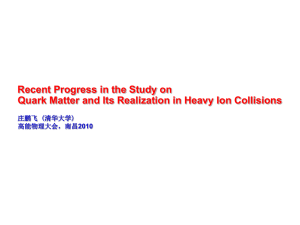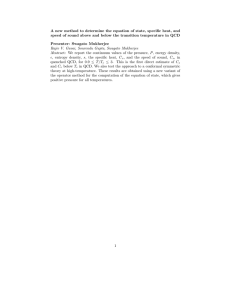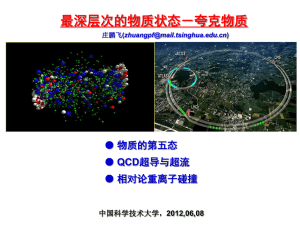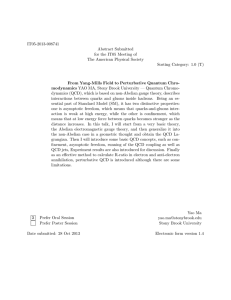Document 11412985
advertisement
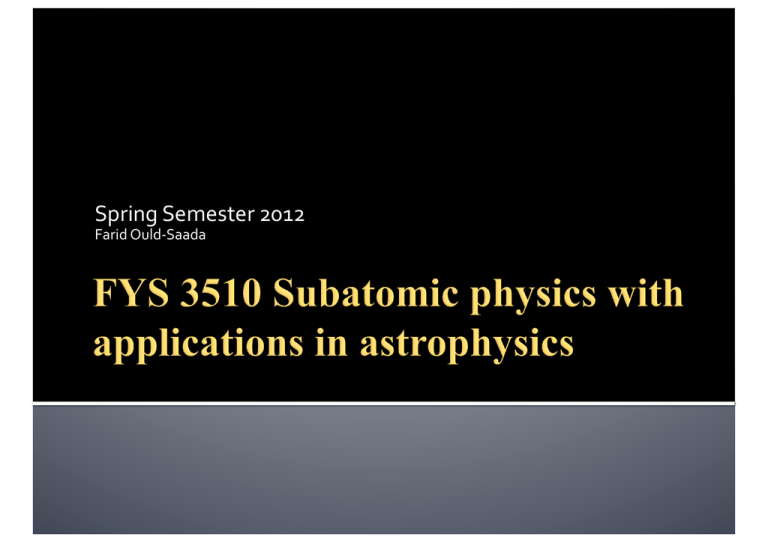
Spring Semester 2012 Farid Ould-­‐Saada Heavy ion collisions and quark-gluon plasma • Section 5.5: quark gluon plasma • CERN Summer student lecture program 2010 Carlos Lourenço, CERN • ALICE and Heavy Ions at LHC Trine Tveter • The ALICE experiment Henrik Qvigstad, CERN visit 2012 Confinement In QCD at normal energy-­‐densities q and g confined within hadrons (confinement not understood) At extremely high E-­‐densities QCD predicts de-­‐confinement of q an g across volume larger compared to that of a hadron new state of matter: quark-­‐gluon plasma ▪ first µs after Big-­‐Bang? Neutron stars? ▪ Lattice QCD transition energy~160-­‐190 MeV 1012K Stages in formation of q-­‐g plasma and subsequent hadron emission (a) 2 heavy nuclei collide at HE (b) interact via colour field (c) de-confinement and plasma formation and possible radiation of photons and lepton-pairs (d) As plasma cools, hadrons condensate and are emitted 5/29/12 F. Ould-Saada 3 RHIC gold-­‐gold ion collisions at 200GeV per nucleon Head-­‐on collisions several 1000 final state particles produced View of a 200 GeV gold-­‐gold interaction in STAR detector at RHIC ALICE, ATLAS, CMS data at LHC, CERN at some TeV/nucleon q-­‐g-­‐plasma signatures: Copious production of strange particles in excess of pp collisions suppression – open charm (D-­‐mesons) favoured Under which conditions can a q-­‐g plasma be made? What are the rules governing evolution and transition to and from this kind of matter? Crucial role in understanding basic nature of confinement! 5/29/12 F. Ould-Saada 4 The following slides (except the last four) are from lectures given by Carlos Lourenço At Summer student lectures, CERN 2010 http://indico.cern.ch/scripts/SSLPdisplay.py?stdate=2010-07-05&nbweeks=7 From High-Energy Heavy-Ion Collisions to Quark Matter Carlos Lourenço, CERN CERN, July 2010 5 Quarks, Gluons and the Strong Interaction A proton is a composite object made of quarks... and gluons No one has ever seen a free quark; QCD is a “confining gauge theory” “Confining” V(r) r “Coulomb” Hadrons = particles composed of quarks and gluons baryons: protons, neutrons, etc : 3 quarks mesons: pions, kaons, J/ψ, etc : 1 quark + 1 antiquark 6 A very very long time ago... quarks and gluons were “free”. As the universe cooled down, they got confined into hadrons and have remained imprisoned ever since... 7 The QCD phase transition QCD calculations indicate that, at a critical temperature around 170 MeV, strongly interacting matter undergoes a phase transition to a new state where the quarks and gluons are no longer confined in hadrons We can create a system of deconfined quarks and gluons • by heating • by compression Lattice QCD calculations Hadronic Nuclear Matter Matter Quark Gluon Plasma (confined)! deconfined 8 The phase diagram of water solid liquid vapor 9 Temperature Tc Early universe The phase diagram of QCD, today quark-gluon plasma hadron gas nucleon gas nuclei ρ0 net baryon density 10 Temperature The true phase diagram is substantially more complex ρ0" baryon density 11 How do we study bulk QCD matter ? • We collide heavy nuclei at very high energies producing a large volume of hot and compressed baryonic matter Pb Pb p π- π+ 12 The time evolution of the QCD matter produced in HI collisions soft physics regime hard (high-pT) probes The “fireball” evolution: • Starts with a “pre-equilibrium state” • Forms a QGP phase (if T is larger than Tc) • At chemical freeze-out, Tch, hadrons stop being produced • At kinetic freeze-out, Tfo, hadrons stop scattering 13 Two labs to recreate the Big-Bang AGS : 1986 – 2000 • Si and Au beams ; √s ~ 5 GeV • only hadronic variables RHIC : 2000 – ? • Au beams ; up to √s = 200 GeV • 4 experiments (only two remain) SPS : 1986 – 2003 • O, S, In, Pb beams ; √s ~ 20 GeV • hadrons, photons and dileptons LHC : 2010 – ? • Pb beams ; up to √s = 5500 GeV • ALICE, CMS and ATLAS 14 One Pb-Pb collision seen by the NA49 TPCs at the CERN SPS (fixed target) 15 One Au-Au collision seen by the STAR TPC Momentum determined by track curvature in magnetic field… 16 What is the question ? We want to study the nature of Quantum Chromo-Dynamics under the extreme conditions which occurred in the earliest stages of the evolution of the Universe We collide high-energy heavy nuclei, to produce hot and dense strongly interacting matter, over extended volumes and lasting a finite time; but the produced system evolves (expands) very fast... How can we “observe” the properties of the QCD matter we create in this way ? How can these “observations” be related to the predicted transition to a phase where colour is deconfined ? 17 Another challenge: creating and calibrating the probes The “probes” must be produced together with the system they probe ! They must be created very early in the collision evolution, so that they exist before the QGP might be formed : ⇒ jets, quarkonia states We must have “trivial” probes, not affected by the dense QCD matter, to serve as baseline reference : ⇒ photons, Drell-Yan dimuons We must have “trivial” collision systems, to understand how the probes are affected in the absence of “new physics” : ⇒ pp, p-nucleus, light ion collisions 18 “Tomography” of the QCD matter produced in HI collisions Tomography in medical imaging : The measured absorption of a calibrated probe gives the 3-D density profile of the medium. Tomography in heavy-ion collisions : - Jet suppression gives the density profile of the matter - Quarkonia suppression gives the state (hadronic or partonic) of the matter Note: “heavy ion physics” is much more than jet and quarkonium suppression… These are just two QGP signatures… easier to explain than the others 19 What is jet quenching ? In pp, expect two back-to-back jets In the QGP, expect mono jets... The “away-side” jet gets absorbed by the dense QCD medium 20 Dense matter absorbs quarks and gluons… but not photons Quarks and gluons interact in the medium and lose energy High energy photons shine through the dense QCD medium photon 21 Jet quenching: setting the stage with pp collisions Azimuthal correlations show strong back-to-back peaks Azimuthal Angular Correlations 22 Jet quenching: discovery mode with central Au-Au collisions Azimuthal correlations show that the “away-side jet” has disappeared... if we only detect high-pT particles, pT > 2 GeV/c Azimuthal Angular Correlations 23 Jet quenching: where is the energy gone? The “away-side” energy is no longer collimated into jets but distributed over many soft particles… seen when the pT threshold is lowered to 200 MeV/c Azimuthal Angular Correlations 24 The “centrality” of a nucleus-nucleus collision The signals of QGP formation should show up in the most “central” nuclear collisions Geometrical parameters of the collision centrality : • b = impact parameter distance between centers of colliding nuclei, perpendicular to the beam-axis • Number of participant nucleons: Npart • Number of binary nucleon-nucleon collisions: Ncoll None of them is directly measured ! Must be derived from measured variables, through models b participants spectators 25 Peripheral collision 26/49 Mid-central collision 27/49 Central collision 28/49 Jet suppression in heavy-ion collisions at RHIC RHIC pp d-Au a ta d e c n refere cess o r p e photons referenc central Au-Au Two-particle azimuthal correlations show back-to-back jets in pp and d-Au collisions; the jet opposite to the high-pT trigger particle “disappears” in central Au-Au collisions The pion yield in central Au-Au is 5 times lower than expected from pp collisions but the photons are not affected by the dense medium Interpretation: the produced hard partons (our probe) are “anomalously absorbed” by the dense colored medium created in central Au+Au collisions at RHIC energies 29 The little bang: a summary by the Scientific American QGP 30 Back to the future: LHC experiments will study QGP properties The search for evidence of QGP formation and the study of its properties will start at the LHC in November, when Pb ions will collide at much higher energies than ever before RHIC SPS LHC 31 LHC: the Large Heavy-ion Collider CMS ALICE ATLAS Details in the next lectures… 32 Observation of a centrality-­‐dependent dijet asymmetry in lead-­‐lead collisions at √sNN = 2.76 TeV with the ATLAS detector at the LHC http://prl.aps.org/abstract/PRL/v105/i25/e252303 5/29/12 F. Ould-Saada 33 F. Ould-Saada 5/29/12 34 ALICE and Heavy Ions at LHC Trine Tveter The ALICE experiment Henrik Qvigstad, CERN FYS3510 visit 2012
